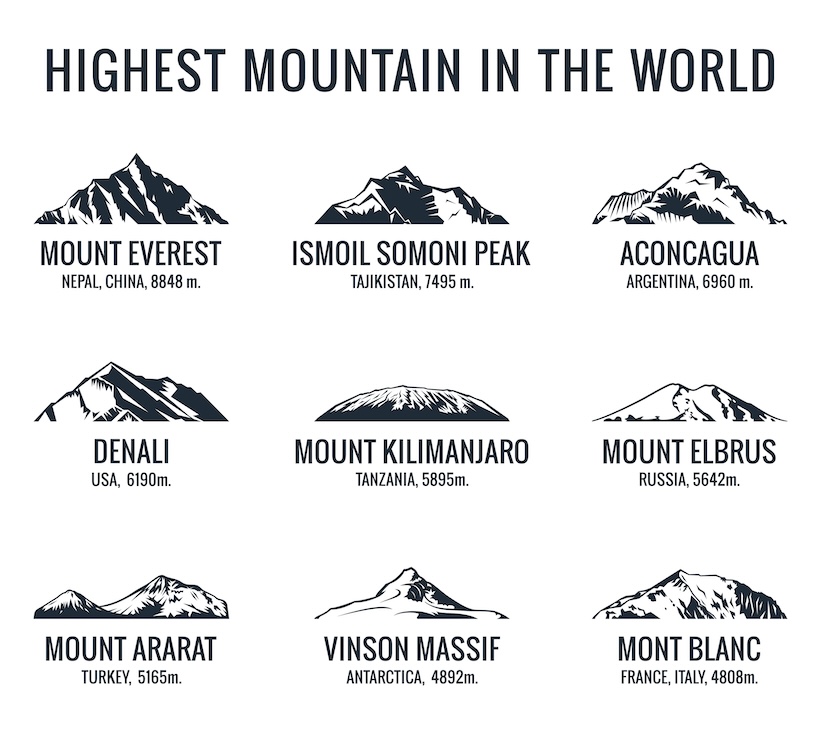Oxygen at Altitude is a Major Consideration in Wilderness Medicine
Wilderness MedicineWilderness medicine covers an enormous area of study and practice. From anaphylaxis to zoonotic diseases, it covers a lot of glossary. From deep-water diving to high-altitude mountaineering, it covers a lot of territory including oxygen deprivation.

Mountain tourist vector logos set. Adventures Icon mount. Highest mountain in world. Everest and Ismoil Somoni Peak, Aconcagua, Denali, McKinley, Kilimanjaro, Elbrus, Ararat, Vinson Massif, Mont Blanc
In this post about wilderness medicine, we focus on four terms in that glossary to which every outdoor educator and backcountry/wilderness guide should be aware:
Oxygen is a gas comprised of two oxygen molecules bound together (O2), that’s essential for the survival of most earthly lifeforms. You can live without food for several weeks, without water for several days, but only a few minutes without oxygen.
Atmosphere is the gaseous mass that surrounds a celestial body like Earth. Earth’s atmosphere is composed of about 78 percent nitrogen, 21 percent oxygen, 0.93 percent argon, and 0.04 percent carbon dioxide, along with trace amounts of other gases and variable water vapor. This gaseous “envelope” is divided into layers ranging from the troposphere to the thermosphere, with the percentage of oxygen remaining the same in each of those layers. (more…)
On Belay — Climbing Terminology and Slang
Outdoor LingoDid you hear the one about Rock and Ice magazine merging with Climbing magazine? It’s not a joke. That news was announced just today (Oct. 9, 2020), and it conveniently coincides with the next post in our series on outdoor industry lingo. With the assistance of The National Center for Outdoor & Adventure Education’s (NCOAE) outdoor lexicon support team (that’s me), most of you were able to make it through the first post in our outdoor industry lingo series — Surfing. And now, just when you thought it was safe to go back to regular English, you get to learn an entirely new language.
For today’s writeup, we’ve got you “on belay” with all the “beta” to get you through the “crux” of the lingo learning curve so you can “on site” any climbing conversation.
Holy crevasse! Why are all those terms in quotation marks? And what do they mean?
Pay attention, Grasshopper. While I can’t (won’t) give you the entire exhaustive list of climbing terms, I am going to go deeper into the nifty nomenclature of climbing. And the first thing you’re going to need to access in order to summit this speech peak, is the climber’s “bible.”
This 60-year-old book is called “Mountaineering: Freedom of the Hills,” and it’s available now in its 9th edition. So, if you want to climb or become a mountaineer, or if you just want to speak intelligently about the topic at climbers gathers or Zooms, get the book. Why? Look around you. Even the most ardent climbers, guides, and outdoor education professionals reference Freedom of the Hills.
So, let’s “tie in” and get you on the “sharp end” by the end of this post. We need to get you talking knowledgably about climbing.
I’m thinking we should start things off with how climbs are rated — the difficulty level. You might hear someone talk about climbing a 5.9 with a 5.12 pitch at the crux. And you don’t have a clue as to what that means. Bottom line? We’re referring to the “Yosemite Decimal System” (YDS).
The Yosemite system is a common and dynamic language. And like ardent surfers talking about big waves, nobody wants to claim they are climbing harder routes than they really are. It’s just too easy to prove that you’re exaggerating. So, is this YDS accurate? If you climb — or attempt to climb — you may come up with the answer yourself.
(more…)TALK TO US
Have any further questions about our courses, what you’ll learn, or what else to expect? Contact us, we’re here to help!
